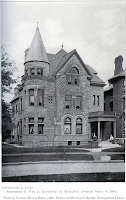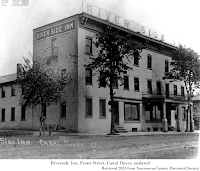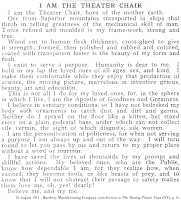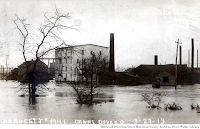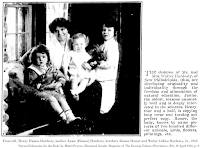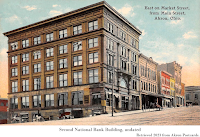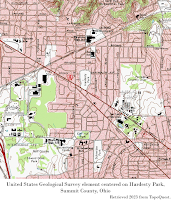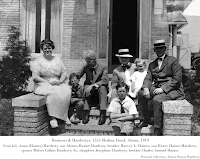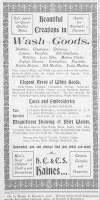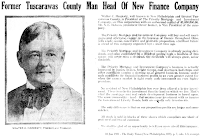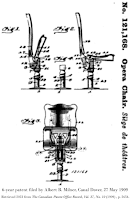Earlier post depicted Walter’s grandfather Thomas Hardesty (c1820-1869), born at what would become Malvern. He succeeded in various interests. Beginning in a Hardesty “legion of millers” composed of his siblings, Thomas expanded into mercantilism. He would purchase Dover City Mills and move to Ohio burgh of Canal Dover in 1866. Near conclusion of forty-nine-year life, Thomas enjoined with Philip Baker (1812-1881) to form the Exchange Bank of Baker & Hardesty.
Walter’s father, Alonzo Haines Hardesty (c1846-1892) married Baker’s daughter Mary Catherine (1849-1914) in 1870.[1] Let us suspect ‘Lon’ was well capitalized: he and only brother William A. Hardesty (1848-1908), as ‘Hardesty Brothers,’ had (served in Company K, 157th Regiment of Ohio Volunteer Infantry, U.S. Army 1864 and) lavishly introduced steam power to Dover mills in the year of Walter’s inception.
 |
| Images enlarge when clicked. |
Walter’s birth order proved difficult to determine. He was twin to Helen Martha (1879-1946), also born 11 April 1879.[2] The pair trailed siblings Harry A. (1871-1955) and Loretta Hardesty (1873-1946). They were all enumerated 1880 at Village of Dover. When Alonzo was depicted as ‘Flour & Grain Dealer.’ At some point in 1879, this Hardesty cluster had entered stately residence on Wooster Avenue (right).
Hardesty Brothers serially bought out Dover competitors’ mills, expanded to Columbus, Ohio. By 1884, patented process produced almost a dozen ‘special brands’ of flour. The duo of Alonzo and William held government supply contracts and partnership attained prosperity that children of their father's nine brothers would never accrue.Walter was not yet age thirteen when his father, “a prosperous and honorable business man … received a fall … that bruised him badly.”[3] Alonzo was likely forty-six when succumbing to a heart attack a few days later. According to a descendant, who opened his elegantly appointed Dover dwelling to me, Alonzo “fell in the Hardesty mill, was brought home in a cart, and died at home.”[4] He was survived on 5 February 1892 by the above household, and subsequent sons Jesse Duncan (1880-1936) and Edgar Alonzo Hardesty (1884-1972).[5]
“Serious and painful accident” no doubt skewed Walter’s trajectory from that of his brothers and cousin. (Uncle William had but sixteen-year-old son Thomas Moore Hardesty (1876-1931) to succeed him at Hardesty Brothers.) Physically challenged, I sense Walter became pointedly cerebral. With superior capacity to parse language, he would tell a biographer he completed his education at Dover … not that he graduated anywhere. He was depicted as ‘Bookkeeper’ in 1900 census. And resident with siblings in their mother’s home … with pair of White servants.
I was unable to discern financial means for it, but Walter C. Hardesty’s fortunes advanced appreciably in 1902. He took title to sizable parcel at New Philadelphia, Ohio ... in bend of Tuscarawas River south of Dover proper. Note Hardesty and Baker Avenues on subdivision map (left). These are surnames of founders of repository that had, after Thomas Hardesty's death, been reorganized as Exchange National Bank at Dover. Advertisement (right) introduces ‘W. C. Hardesty’ as flamboyant. The twenty-two-year-old – as property developer – promised to gift a pair of homes. “All who will invest” in his ‘prize’ lots “will make money, some a small fortune” assured the neophyte. With office on Factory Street, Walter operated out of what Tuscarawas Lodge 59, Free and Accepted Masons (meeting on third floor) described as ‘Hardesty Building.’ It was an operations center for Hardesty Brothers.
For many years, sales of $250 lots appeared in public notices. Legally entered as ‘Hardesty’s Allotment,’ notices regularly brandished sales from (and defaults at) ‘Free Home Allotment.’
Twins Helen and Walter Hardesty went to Sabetha, Kansas and on 24 April 1902 Walter married Anna Haines (1881-1931). Helen served as Bridesmaid for the fourth daughter, seventh child of Henry Clay Haines (1844-1924) and Josephine Hartzell (1850-1925). ‘Annie’ had been at Monticello Female Seminary, Godfrey, Illinois, as late as 1901.[6] Was more classically educated than the groom. Front-page paragraph in The Sabetha Star proved perceptive even in its brevity: “Miss Haines is one of our most accomplished and handsome ladies and Mr. Hardesty is a prominent business man of his home city, being interested in many different enterprises there.”
It will become notable that a Congregational pastor presided over home wedding well-attended by Haines clan. Walter would soon enough distance himself from Christian oversight.
Recall ‘Haines’ also in Alonzo Hardesty’s name. Walter’s grandfather Thomas Hardesty had almost assuredly venerated Malvern tinware proprietor Alonzo R. Haines with the naming.[7] Henry Clay Haines, born at what was then styled ‘Canal Dover,’ Tuscarawas County, Ohio was conceivably brother to Alonzo R. Haines: I contend Walter may have married niece of a man his grandfather admired.
Annie’s next-eldest sister, Grace (Haines) Krantz (c1874-1965) had married at Kansas. And returned with groom in 1898 to eventually take up housekeeping at 510 Wooster Avenue, Canal Dover. At beginning of June 1900, Miss Annie Haines departed Sabetha to visit Grace and spend summer visiting “friends in the east.” Newlyweds Walter and Annie initially located with his mother Mary Catherine (Baker) Hardesty … at 530 Wooster Avenue, and we may have evidence as to how the couple had joined one another’s orbits.[8]
Annie may have entered Hardesty union with a dowry. Her father, proprietor of dry goods store (left) that had branched into clothing and then rugs, had prospered. “The house enjoyed immense trade” crowed The Sabetha Republican-Herald in 1894. “Mr. H. C. Haines has large interests in other towns …” By date of Annie’s marriage, Haines was a Director in National Bank of Sabetha.
“On Monday evening Mr. and Mrs. H. C. Haines received the following telegram: "Forest Haines Hardesty arrived at the home of Mr. and Mrs. W. C. Hardesty,"” The Sabetha Star announced on front page 29 January 1903. Forest Hartzell Haines (1877-1936) was Annie’s next-eldest brother. Her first child was born almost precisely nine months following marriage. He did not survive.
I was able to scour from German-language Der Deutsche Beobachter announcement that Republicans 19 March 1903 had nominated W. C. Hardesty to represent Second Ward, Canal Dover “stadtrath” … or City Council. In another disappointment, I do not suspect the candidate prevailed.
[See introductory note following post conclusion for disambiguation regarding 'W. C. Hardesty.']Walter’s Uncle William expired at his luxurious Columbus manse (left) 21 November 1903. An industry insider speculated “It is not definitely decided by the heirs whether the business will be continued or closed out.”[9] Hardesty Brothers (now nephews) reconfigured as Hardesty Milling Company, whose Dover mill promptly underwent $14,000 remodel. Cornering markets, the firm went on to broker flour on the Produce Exchange at New York City. Walter no doubt drew from this revenue. William A. Hardesty had been diversifying, holding directorships in a variety of manufacturing and financial operations. Walter Hardesty, independent of his brothers, followed suit. He was described in 1903 as Secretary for A. R. Milner Seating Company at neighboring New Philadelphia.
Secretary Hardesty was sole signatory to Milner Seating Company’s public, July 1904 exposé of Canal Dover’s First Methodist Episcopal Church Pastor. Letter to The Daily Times turned inquisitorial: “Why did you purchase pews from the same company at the last church of which you were pastor?” After Milner firm’s bid – to fill order $200 beneath lowest received – was rejected, readers were given bold insinuation of insider dealing.
News broke 8 September 1904: “Dover’s Opera House Leased To Walter Hardesty Who Will Improve It.” Promising to invest $5,000 enlarging stage and “improving and beautifying the theater … new scenery will be procured and everything done to make it a first class play house …”[10] The Daily Times described Walter as “progressive,” assured readers new management “knows what shows to engage.” I'll contend he also demonstrated a builder’s acumen.
“Since the purchase of the theater by the Hardesty Amusement Co., workmen have been busy remodeling the building until it resembles an up to-date playhouse” gushed The Daily Times at end of October. “Revolving opera chairs manufactured by the Milner company” had been installed on newly elevated floor. Two tiers of boxed seats were set curtain-side, ten boxes added to the gallery. Reportage on formal dedication before “fashionable audience” advised “drapings of rich green” and comfortable chairs in the boxes “present a very tasty appearance.” As these observations inform Hardesty’s subsequent creation of opulent environment, sumptuous appointments seem noteworthy: frescoed ceilings and walls, addition of smoking room and “dressing room for the ladies.” Ushers had been furnished “neat suits of green trimmed with gold braid.”
And yet Hardesty was practical in his installation. “All precaution has been taken for the safety of patrons.” Plush drapery fronted asbestos curtain; exits were marked by red lamps before legislation required such.
According to Lautzenheiser, Hardesty bought himself entre to the likes of “Douglas Fairbanks, Will Rogers, minstrel performer Al Jolson, and the Sousa Band.”[11] [Opera House in industrial setting depicted at ‘Wild Confusion.’ Hear Jolson warbling at FindingEverett.]
‘Hardesty’s New Theater’ embraced dynamism on Election Night, 5 November 1904. Fourteen vaudeville acts and thirty-five-piece band performed. “Election results will be received by special wire and read from the stage.” In era preceding radio as commercial endeavor; near instantaneous communication must have been a marvel. With award of 336 votes in the U.S. Electoral College (and plurality of a million votes nationally), Theodore Roosevelt, Jr. (1858-1919) was elected President.
Hardesty bought from Albert Russel Milner (c1857-1938) his Seating Company. He put next-youngest brother Jesse Duncan Hardesty … just turned twenty-five and living with their mother … in as Manager.
Milner, persisting in opera chair market, promptly raised capital for firm bearing same name he’d sold Hardesty. Litigation began almost immediately.[12] Hardesty had timed his venture well: as nickelodeons and vaudeville houses gave way to motion-picture theaters, he found demand for narrower chairs that accommodated larger audiences on existing floor plans. Soon, mechanical seats would dutifully spring up at patron egress. Theater owners added efficiency when rooms were swept between screenings.
Our subject became Walter Collins Hardesty, Sr. at birth of same-named son to Annie. Likely on 12 November 1904.[13] (Annie appeared in some of Walter’s land transactions in this era … as property co-owner; she apparently retained her own wealth.[14] The Daily Times reported “Mrs. Walter C. Hardesty gave a theater party in honor of some of her friends” 13 January 1905.
Walter, Sr. raised cash. Parcels in his Free Home Allotment had been selling at brisk pace. Well-attended comic opera The Princess Chic had 23 March 1905 been declared “equal to any big city attraction” and “by far the finest attraction in the musical comedy line that ever played in this city.” Yet 7 October he obtained $5584 in land deal with maternal aunt Loretta (Baker) DeGrief (1854-1936). As was his mother, Aunt Loretta was a Director of the Baker family’s Exchange National Bank (above) at Dover.“Mr. Hardesty goes to Chicago to take charge of the Milner Seating Co. offices which were recently moved there from this city,” The Daily Times disclosed 18 September 1905. “After October 1st the name will be changed from the Milner Seating Co. to the Hardesty Manufacturing Co. and will manufacture up-to-date opera chairs ...” Annie was reportedly on that train: in pursuit of future Chicago, Illinois home with Walters Sr. and Jr.
Scant notice had appeared in New Philadelphia’s The Daily Times 24 August 1905, but scouting trip is illuminating: “Walter C. Hardesty m’g’r. of the Milner Seating Co., of this city, is in Chicago this week in the interest of the new opera chair he has just put on the market.” We have suggestion of innovative product design, evidence that he did not feel tethered to Canal Dover. Further, he did not feel tethered to Chicago: from railroad nexus, Walter barnstormed in the most extensive traveling phase of his careers.
Scientific American readers were offered innovative Valet Chair in time for Christmas. Generally presenting as jauntily attired, Walter as Traveling Salesman may have woken to rumpled suit in hotels for weeks at a time. Chair combined trouser press with shoe tree and polishing station, even stowed a man’s hat. Hardesty Manufacturing Company, from business office in Fisher Building at Chicago, offered Colonial, Old Mission and Regular style product lines, would custom-fashion “in any wood style finish to match other furniture.” I found the stark woodcut and typographic layout (right) handsome.
Hardesty Manufacturing brought a bookkeeper in from Toledo, Ohio at end of 1905. Spin in The Daily Times declared “Business has grown so rapidly within the last few months that the old system has become insufficient.” This may be true. I can also aver that unmarried Manager and co-heir Jesse Duncan Hardesty (still under Guardianship) appeared in society columns after his brother’s departure for Chicago … as galivanting around. Though not as prolifically as their age-intervening brother Edgar, who was, I deduce, a most eligible bachelor.
State of Ohio Inspection Report of Canal Dover facilities recorded twenty-five males laboring at Hardesty Manufacturing Company in 1906. On Opera Chairs. Two dozen males tended two flour mills and barrel-making facility operated by Hardesty Milling Co. Despite having relocated to Chicago, sale of $250 lots in Hardesty’s Free Home Allotment at Dover were recorded every month; productions at Hardesty Theater drew satisfying audiences. Yet Walter remained in concerted travel on behalf of his furniture.
Annie, with babe Walter, Jr., in the summer of 1906 spent time among Dover in-laws and family at Sabetha. On 14 September, she, her sister Grace and their children, with their mother Josephine, convened on Chicago. Ten days later Walter, Sr. returned to Dover with wife and child: Windy City would no longer be his base of operations. Perhaps it was pre-planned withdrawal.
Walter was manifested as Vice President and a Director of Exchange National Bank at Dover. He was also Stockholder in Cleveland-based Indemnity Savings and Loan when it went defunct that year.
Burch’s Official City Directory for New Philadelphia and Canal Dover, 1907 depicted a nest of Hardesty brothers in leadership roles for multiple corporate entities. W. C. Hardesty appeared as President of Hardesty Milling Company. (Eldest brother Harry undoubtedly had acumen: he had opened London office in 1901, was in 1907 Manhattan agent for the firm, and would in 1910 describe living on ‘own income’ and semi-retired to Rahway, New Jersey at age thirty-nine.) Walter was listed as Vice-President, Hardesty Manufacturing Company. (Youngest brother Edgar Alonzo, age 22, appeared as President.)[15] Walter, Annie and Walter, Jr. took up residence at Riverside Inn, Canal Dover (above). Proximate to flour mills and manufactory in gritty industrial area. Hard work had paid off: on 2 May an extra shift of workers were put on, at Dover “seating works” of Manufacturing Company. Having been absent from active management, he promptly sub-leased opera house … which continued operations as Hardesty’s Theater.
“Walter C. Hardesty retires from the direction of the theatre after several successful seasons” The Daily Times announced 14 August 1908. Perhaps he responded to the pull of other calls on his time and energy: another year remained on his 1904 lease. Returned to prior management, operations again reconstituted as Big Four Opera House … yet Stark County Democrat the following month declared Canal Dover Secular Society would assemble annual convention at Hardesty Theater. Just in time for Labor Day.
I identified Walter by September 1909 with a most extraordinary endeavor. Leading Saturday evening session, he addressed the Buckeye Secular Union … convened at Hardesty Theater. Noted the society’s secretary: “Mr. Walter C. Hardesty, of Canal Dover, pointed out the beauties of practical "Idealism." Not a word too many, not a word too few – a perfect little literary gem, evincing a talent which Mr. Hardesty, who is a quite young man, would do well to put in frequent practice.” We shall see about that. Walter was but a few months past age thirty.
Walter moderated debate that “principles of Secularism are better adopted to meet the needs and promote the welfare of the human family than the principles of Christianity” the following February. At Dover Opera House. Hardesty was apparently not long at this propagandism, I remain unclear as to his motivation. Perhaps I romanticize, but the sect described themselves as freethinkers; their practice (was attractive to Socialists and) did not appear to be anti-religious … but adherents were not hemmed in by superstition and false belief. I’d style him agnostic humanist for his position and public effort. I contend Walter’s optimism will come into plain view. That he walked tightrope for ‘practical’ idealism.
Of all possible depictions, sometime Banker and Merchant Miller Walter C. Hardesty was in 1910 census simplistically recorded as ‘Manufacturer, Furniture.’[17]
Tuscarawas County Children’s Home occupied 45-acre property along South Tuscarawas Avenue. Lucretia Cain (b 1897) had been bouncing among her mother’s people from time of her birth, and for six months been inmate of the Home. On 4 August 1911, in third escape attempt, “she went to the Hardesty home and asked if she might stay there all night.” I think it credits our subjects that The Daily Times on front page divulged “She was given a place to sleep.” The School Superintendent was notified, Lucretia was returned to the facility the following day.
Multiple-reel films, coming to be known as ‘features’ in vaudevillian sense of billing attraction, began keeping moviegoers longer in seats. 12 August 1911 issue of The Moving Picture News obligingly reviewed Hardesty’s “pedestal automatic folding all-aisle chair” where patron safety predominated over comfort in assessment. As “safeguard against theater panics,” and to overcome “feeling of insecurity as to the disastrous effect in case of fire …” should seating not permit easy access to exits.
Two weeks later the trade journal published “I Am the Theater Chair,” (left) an extraordinary bit of marketing from long-running advertiser. Hardesty Manufacturing Company offered $25 to any film exhibitor able to surpass quarter-page prose poem. Amidst pæan to engineering and science appeared “I exist to serve a purpose. Humanity is dear to me.” And “I am the personification of politeness …” It is tempting to associate “I am the Apostle of Goodness and Greatness,” with freethinking, humanist copywriter oddly externalizing his values.
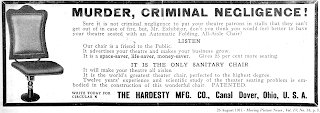 Mystery-detective formed as genre in French silent film from 1908. Whimsical advertisement in same issue (right) teased into Americanization of the milieu. Relied on the same titillation scriptwriters sought to employ.
Mystery-detective formed as genre in French silent film from 1908. Whimsical advertisement in same issue (right) teased into Americanization of the milieu. Relied on the same titillation scriptwriters sought to employ.
Annie hostessed two-course lunch for seventy-five guests at Tuscarawas Avenue home 17 October 1911 … “in charmingly appointed affair” honoring her mother Josephine (Hartzell) Haines of Sabetha, Kansas. The Daily Times confided “The afternoon was spent [playing] point euchre …”
Penchant for humanity may have been Annie’s province. She was by 1912 active within Sorosis. I was unable to discern whether she confined participation to poetry analysis, or Dover Chapter embraced broader women’s organization for its philanthropy and social reforms … which included training for immigrant women. [18] Annie was again with child. Alonzo Homer Hardesty (1912-1955) would be born 24 October … while Walter embroiled himself in other pursuits.

“These are Walter C. Hardesty’s opinions of the Republican convention at Chicago,” reported The Daily Times 22 June 1912.[19] According to him, sitting U.S. President (and Ohioan) William Howard Taft (1857-1930) “has spent too much money during this campaign, and he can’t afford to quit.” Hardesty correctly predicted Republican machine would nominate Taft, erred about Theodore Roosevelt’s delegates' decision to “bolt” and form Progressive Party.
In close race, Walter secured Republican nomination in July … to represent Tuscarawas County as Ohio State Representative. “I am laying plans now for a real republican campaign,” Hardesty told the New Philadelphia Democrat and Times in August. Who declared him “one of the most aggressive Taft men in the county.” After what had been largely in-party scrap far from idealism, November returns ultimately favored a candidate who had transited to Bull Moose party. It would be Walter’s last expedition into elected office.
Walter was not in Ohio House of Representatives when debate turned to Tuscarawas flood of March 1913. The Hardestys’ Cascade Mills at Dover (right) suffered damage requiring weeks of repairs. Production ramped up at Hardesty Manufacturing Company, however: call for additional Iron Moulders went out in the summer.
Walter’s mother, Mary Catherine (Baker) Hardesty, died at her Wooster Avenue home – of Bright’s Disease – 14 February 1914: obituary headline read ‘Director of Bank Claimed’ as if fiscal withdrawal had occurred. She was age 65, survived by brothers and sister Loretta at Exchange National Bank, three sons and three daughters. Guided by Moravian officiant, she followed husband Alonzo into Hardesty Mausoleum, Maple Grove Cemetery, Dover.
“Flying visit” to mother-in-law at Sabetha portrayed Walter C. Hardesty in solo progression that included Chicago, Omaha, Nebraska and Kansas City, Missouri “in the interests of a remarkable theatre chair he has patented and is manufacturing.” The chair proved Hardesty is “not only a brainy inventor, but a public benefactor” to The Sabetha Herald 30 July 1914 … probably reliant on the salesman and not an actual, physical seat to extol safe exit from a theater as beneficence. “When a person arises from his seat in the picture house, the chair shuts up automatically and turns around, left-face straight up like a soldier, leaving the space free and the entire theatre is turned into rows of aisles instead of chairs.” Ads ran in The Billboard, “America’s Leading Theatrical Weekly” (above).Clouds of discord parted and, in August 1914, allied European states declared war on Central Powers of Austria and Germany.
Mrs. Walter C. Hardesty had for years regularly appeared in society column as (guest at and) luncheon party organizer. Her 14 August 1914 initiative surfaced values and language skills. Walter had born advertising cost, for announcement half a column deep: Annie for days summonsed to their home parents “interested in providing better educational facilities for their children.” Futher, she had arranged attendance by Miss Gladys E. Burrows, recent graduate of the Second International Montessori Training School at Rome.[20] [The author’s children were educated a hundred years subsequent within model developed by Dr. Maria Tecla Artemisia Montessori (1870-1952).]
Mother to three surviving children – ages 21 months to nine years – Annie intended “enlightened parents … realize how disastrous is the socialistic leveling process of the public schools, which by stunting the natural physical, natural moral and natural intellectual growth, threatens our very civilization.” Hers was non-standard objective for students: “the building of a strong physique, the retention of individuality in the child, the development of initiative, the cultivation of self-control, all of which will be accomplished through the medium of self-education and under the direction of one well versed in child psychology.”
“When Mrs. Charley Haines got on
the train at Chicago, returning from her recent trip, she bought a February [issue
of] American Magazine,” divulged Sabetha
Herald 11 March 1915. Under ‘Sabetha Grandchildren and the National
Prodigy’ headline, Annie’s sister-in-law Francis (Moon) Haines (1873-1951) was
reported to have read Moulton’s article,
‘A Twelve-Year-Old Wonder Child,’ while en route. Had digested remarkable
“intellectual achievements” obtained by Winifred Sackville Stoner (c1870-1931) in
‘Natural Education’ of her same-named daughter. “When she reached Sabetha, [Francis]
found Mrs. Stoner’s book "Natural Education," awaiting her in her
mail, and a letter from her sister-in-law, Mrs. Walter Hardesty, of Canal
Dover, O., with the information that the great Mrs. Stoner and her wonderful daughter,
Winifred, had been week-end guests of Mr. and Mrs. Hardesty.”
“It has long been an ambition of Mr. and Mrs. Hardesty to educate their children along similar lines as those taught by Mrs. Stoner,” the Herald continued. The couple were no dilletantes. It seems apparent the pair were very intentional in deriving educational technique for children they considered exceptional. “Of their distinguished guests Mrs. Hardesty says one could scarcely believe that anyone could be taught so much and be amused at the same time.” “Little Alonzo Hardesty,” not yet two and a half years old and in fascinated manipulation of puzzle parts idly provided, prompted Stoner to invent a new instructional game. “In the letter to Mrs. Haines were enclosed charming photographs of Winifred Stoner and the three handsome Hardesty children.”
Consider personal initiative and belief in innate intelligence: Annie presented as highly compatible match for Walter, advocate of practical idealism. Her ‘Teaching my Boys at Home by the Natural Method of Education’ filled a page of The Ladies World, which by January 1916 publication had a million readers. Photo shoot appearing in Illustrated Sunday Magazine of The Evening Tribune at the end of April (above) asserted sons were developing “originality and individuality” … as if prodigies.
W. C. Hardesty made substantial change to his real estate practice. Notice of New Philadelphia lot sales had continued apace. And trailed off abruptly in 1915. He may have incrementally sold off his entire allotment. By whatever means, he financed $35,000 to purchase 30-acre parcel near western city limits of Akron, Ohio 12 February 1916. About fifty miles straight-line and due north from his home. “Hardesty proposes to allot the land and build several homes,” announced front page of The Akron Times.
Within weeks W. C. Hardesty Realty Company had offices in Akron’s Second National Bank Building (right). By mid-April the firm was advertising for a pair of earnest and ambitious men to join ‘selling force.’ Experience was unnecessary: “We teach you how.” Automobile ownership quickly materialized as requirement for commission on sales of Maple Heights lots. It was hot labor market: by 1916 the Goodyear Company had become the world’s largest tire manufactory … and they contended with Firestone and General Tire and Rubber Companies for Akron workforce.
Annie made the adjustment. Akron Beacon Journal Society Page on 12 May very nearly led with theater party, followed by “elaborate supper” served at the home of Mr. and Mrs. Walter Hardesty. The family made themselves comfortable at three-bedroom Bloomfield Avenue residence. First-floor solarium seemed civilized, large dining room and kitchen, accommodating. Finished third floor and basement garage may have been step up from New Philadelphia bungalow.
Near quarter-page advertising campaign commenced in time for 4th-of-July invitation to Maple Heights, ‘The Garden Spot of Akron.’ “Where doctor bills are not known and where the smoke of the city never reaches you and where life with your loved one is one round of pleasure.” Indeed, park with equipped playground had been erected in grove accessed by (still extant) Hardesty Boulevard. “Telephone and we will send one of our motor cars to your residence at any time,” ads read. Prospects were encouraged to bring dinners, eat on outdoor tables “without obligation.” Every child accompanied by a parent on holiday was to receive a baseball, bat, fan or balloon.
On the 8th, “for a figure approximating $75,000,” W. C. Hardesty Realty Company took title to 54-acre farm three miles North of Maple Heights allotment. 1,600-foot frontage along West Market Street “was to be allotted” according to disclosure. The firm – before end of July propositioning for several young men “holding good factory positions” to bring in prospective lot buyers – incorporated at Columbus. Akron directory would declare $50,000 capitalization. Second real estate transfer at Maple Heights, in September, recorded seller’s title had been held by Walter C. and Annie Hardesty.[21]
Walter had likely “sold out” his milling interests, but notice provided historical context: “The [Dover] Chamber of Commerce man thinks it would be a good idea for the Farmers and their friends in this neighborhood to get together and build a grain elevator, thus enabling them, by a little further organization, to market their wheat to the best advantage.” 25 August 1916 contention offered glimpse into business model that had funneled profits to Hardesty brothers for generations: “Cash wheat brings in the Toledo market $1.57 net, the best price offered to his farmer friends in this market is $1.40. Many towns offers $1.42. Freight charges on a carload of wheat from New Philadelphia to Toledo is less than six cents a bushel. That 11 cent differential seems to him to be too big. "Hardesty Milling company of Dover, fixes the price in this vicinity," is the answer that the local dealers give.”
Mr. and Mrs. W. C. Hardesty entertained employees of surveyors firm Gehres and Ritchie 17 December 1916. A multi-course dinner party for ten guests was followed by musical duet. Annie almost immediately began soliciting “competent girl for general housework” in “pleasant surroundings” on Bloomfield Avenue 22 December 1916. Her classified ad ran through end of the year.
Notice of title transfers by W. C. Hardesty Realty Co. began appearing, in clusters, from dinner party forward. A solid majority appeared as financed lot purchases, but down payments no doubt financed operations and “good salary” Annie offered domestic ‘girl.’ Given his prior leadership of Exchange National Bank at Canal Dover, it does not seem incongruous that property finance would emerge in Akron business model.[22]
News arrived from New Philadelphia. “Mr. Clark moved to this city only a short time ago and purchased the beautiful Hardesty bungalow in Tuscarawas avenue.” Poignantly, “[Clark’s] wife died just one week after her arrival here,” The Daily Times observed … when reporting the metalworker’s suicide 29 May 1917. John and Emma Clark left behind a son, born 30 January 1916. Tragic reporting offers counterpoint for our subjects’ relatively charmed life. Note that depiction of home’s beauty did not arrive from real estate bluster. That Walter and Annie could recognize pleasant living spaces will be made abundantly clear.
The United States declared war on the German Empire 6 April 1917. Draft registration card for Walter Collins Hardesty was undated. As it denoted ‘Lost leg,’ he was physically disqualified for service and was unlikely to have been among potential combatants summonsed in June.[23] Record reveals him to have been of medium height and build, with brown eyes and hair. The ‘Real Estate Dealer’ gave Annie as nearest relative.
The American Contractor announced plans were complete for $25,000 W. C. Hardesty home, on West Market Street, Akron.[24] Construction bids would be received until about 5 June. Architectural firm had designed two-story structure … of stucco, tile and stone. It will prove enlightening that Landscape Architect Albert Davis Taylor (1883-1951) was identified with this project. For housing cost comparison, Hardesty expected to spend $3,200 to build two-story, wooden frame home … likely speculating on its resale at Akron allotment.
A competing agency described “beautiful "Hardesty Park," which will be improved” when listing a building lot in August. W. C. Hardesty Realty Company in late 1917 began listing properties beyond Maple Heights and Park View lots, performing as a proper city-wide brokerage. I found it interesting that the firm offered three, new-model automobiles for “cash or terms” on 1 December, likely the property of departing servicemen.
A direct descendant now living provided first, enduring memory of how Annie had been preserved in family lore: she knew her great-grandmother by retelling that she was to have been a noteworthy pianist. Annie lent her talents to war effort: when an entertainment benefitting the Red Cross was organized 12 December 1917, she accompanied church orchestra on piano.
Annie had been pregnant. She birthed daughter Josephine (1918-1965) 7 March. Though Walter had age peer as paternal first cousin Josephine, I suspect name accommodated the child’s maternal grandmother.
It’s challenging to convey the degree of social fluctuation European conflict was occasioning at Akron: Walter’s firm was not consistently well-represented among myriad of housing transactions for folks relocating, yet in June 1918 his office solicited for Bookkeeper/Stenographer. Annie sought another ‘competent girl’ in July … stipulating “no washing” among responsibilities. Frankly, until listing three properties in September, W. C. Hardesty Realty Company was most often reflected in classified ads seeking salesmen. The firm did not appear as market leader.
Hardesty listed his Bloomfield Avenue property in October. His family had outgrown three bedrooms. Asking price was $7,000, with “liberal terms.” Soon enough, the Hardestys ensconced themselves in thirteen-room home (left) on larger, Medina Avenue parcel at West Akron. Amidst three bathrooms and two lavatories, with hot water heating plant and inbuilt vacuum cleaning system. Oak-paneled walls and ornamental ceiling on first floor simulated an English interior. Walter would call it “A real personality home.”
Perhaps result was due to addition of a Sales Manager: Hardesty Realty finished 1918 more effectively. Other firms, including Commercial Savings and Trust, offered Hardesty Boulevard lots for sale, Walter’s firm did not. It may be that Walter had divested himself from the allotment.
Large number of homes on the market may have been predicated on capitalism’s lapse. The U.S. economy had teetered through recession when pandemic overlaid world war’s conclusion. Nearly 30% decline in U.S. business activity followed 1918 armistice. ‘Economic retreat’ intermixed with ‘modest recovery’ in unsettled conditions. The ‘active member’ of Akron Real Estate Board was undoubtedly hard at work in 1919; property listings escalated (including a single $1600 Park View lot) but – in new practices – the company advertised for clients and brokered rental properties. Classified advertising (above right) appeared almost daily in endless columns among competitor listings. Walter’s firm began distinguishing offers with star-shaped die-cuts; experimented briefly with sunny, modern, multi-column display ad splashed across all listings in single grouping.
In April 1919 Walter for first time expressed willingness to enjoin women as agents. On 19 June Ohio became fifth U.S. State to ratify Nineteenth Amendment; the state legislature would also pass a bill ensuring Ohio women’s right to vote in November 1920 elections … regardless of national outcome.
Two of Annie’s brothers, Harvey and 'Charley' Haines joined her, probably in the summer of 1919, for group portrait (left) on front stoop at Medina Avenue. Her firstborn, Walter, Jr. (then age 16), may have been photographer: he was only child of hers not depicted. Annie was in pearls. Note Walter, Sr. – with jaunty brim on straw ‘boater’ hat – sported blousy bow tie. It was trademark neckwear. From Josephine’s depiction above, we might assume it was in this period that her portrait with Annie (left) was rendered. Less than life-sized, unsigned oil painting is nevertheless estimable. Annie no doubt desired to be rendered (with rough-cut delphinium and) out of doors. May have had predilection for river’s tranquility. Pose to me suggests composition was ready-made for magazine cover: I perceive space for superimposition of Saturday Evening Post typescript. Nevertheless, canvas states ‘class.’ The Hardestys had wealth, valued living space adorned by personification in artists’ work. “Square-jawed, firm lipped” Charles Samuel ‘Charley’ Haines (1869-1950) appeared prominently (and in caricature) in 22 November 1919 issue of nationally syndicated The Country Gentleman. Profile recorded he had five sisters and, on first buying trip to Chicago and New York – in 1890s, after their father Henry had taken him into his dry goods business – Charley went east with “commissions from each of them to buy for her some stylish things she wanted to wear, but which were not sold in any store in Sabetha.” Annie and sister’s penchant for finer things in life had helped Haines Store emerge from saturated market for general farm merchandise … to product lines directed at woman buyers. Charley’s acquiescence proved distinctive, and quite lucrative. Farmwives might be sent to town for a hoe, buy it from merchant offering latest fashion in corsets. Next-generation stores in Haines family prevailed in ready-to-wear clothing even as Sears, Roebuck and Company dominated in catalog-based sales.
“Enclosed find $10 check for Bernice Benner from one who has been walking on an artificial leg for 27 years, since the age of 13,” Walter C. Hardesty wrote. Most sincerely. The Akron Beacon Journal reproduced 11 Dec 1919 sentiments offered to a child whose legs had been crushed and mangled by railroad car rolling suddlenly in the yard. They manifested extraordinary self-disclosure: “With me, the loss has been no misfortune; in fact, it may have been good fortune, and I believe, judging from the looks of little Miss Benner, she will find a way to use her head, heart and hands that will fully recompense her for her loss.”[25] Walter valued thought, emotional engagement, and tactile execution. He concluded by “wishing for her the best that the world affords.” Judging by future events, the impartation may disclose Walter’s own, compensatory inclination.
Walter Hardesty (age 40) was enumerated 10 January 1920 as self-employed Real Estate Agent. 1470 West Market Street residence was owned free of any mortgage. With him and Annie (39) were Walter, Jr. (15), Henry (9), Homer (7) and Josephine (22 months). All but the baby ‘attended school’ in 1919. Neighbors included retired banker, owners of flour mill and manufactory.
The Federal Reserve Bank of New York began raising interest rates sharply. In December 1919 the rate was raised from 4.75% to 5%. A month later it was raised to 6%, and in June 1920 cost of Federal borrowing rose to a then-unprecedented 7%.
In uncertain times, Priority Mortgage & Investment Company filed as Akron securities firm, with Walter C. Hardesty, President, on 31 August 1920. By October report to the Ohio Secretary of State, the enterprise was reportedly capitalized at $1,000,000.[26] The Secretary declared Hardesty Mfg. Company at Canal Dover officially dissolved 15 November. November-December call for “salesmen who want to succeed in a big way, selling a financial stock founded upon the safest of all securities” (right) was ostentatious. Booming Walter intended to profit from those akin to “hundreds of successful men [who] have started with me in the past few years.” “Former Tuscarawas County Man Head Of New Finance Company,” came declaration (excerpted, left) five columns wide in New Philadelphia’s The Daily Times 10 January 1921. Walter C. Hardesty, “an allotment specialist and successful real estate operator,” was presented as President and Treasurer of the mortgage and investment company. Operations expanded at his offices in Akron’s Second National Bank Building. Announcement presented an experienced Board of Directors: a banker, and capitalist drawing wealth from coal, served as Vice Presidents. From the trades, Architect, and construction contractor at Cleveland, wisely rounded them out. “Leading firm of Akron” served as Attorneys for the Company. Slabaugh, Young, Seiberling, Huber & Guinther, with offices in the same building, had state-wide renown: they would retrieve bad debts and, ultimately, represent Hardesty in his own difficulties.
Financial conditions worsened: U.S. business activity declined a whopping 33% in 1921. Retrospective admits the nation had entered economic depression. Warren Gamaliel Harding (1865-1923) entered office as U.S. President in March.
“Fascinating” Josephine Hardesty appeared prominently (left) upon Akron Beacon Journal’s Home Magazine Page 7 May 1921. Dance performance as ‘Diller a Dollar, the Ten O’Clock Scholar,’ bears some analysis. The Hardestys did not confine accelerated, early childhood aspirations to male offspring. Also consider that, in Yorkshire dialect for the Mother Goose rhyme, ‘diller’ was term for dim-witted/lazy student … one who dilly-dallies.[27] While laudable as evidence of concentrated parental attentions, intent for scholarship and cultural performance while shaming tardiness seemed weighty messaging for a child just turned three years of age. Wrapped up as it was in gaiety and adoration.
“Mr. and Mrs. H. A. Hardesty … are stopping in Orlando for a few days rest en route to southern points for the winter,” the Orlando Morning Sentinel had disclosed 20 November 1920. Walter, Sr.’s elder brother Harry was then “making the trip south by motor” with wife of seventeen years, Josephine (Levy) Hardesty (1882-1975). The couple, acclimated to leisure and auspicious conditions, returned to seasonal residence near Daytona Beach in the winter of 1921.
“Walter C. Hardesty, 1555 Medina rd., is sojourning for two weeks in Palm Beach, Miami and St. Petersburg, Fla.” reported Akron Beacon Journal 19 January 1922.[28] “Upon his return trip he will stop at Sea Breeze, Fla. to visit his brother, Harry A. Hardesty of Philadelphia, Pa. and New York.”
Something profound and life changing happened to forty-two-year-old Walter. Perhaps sojourn was through mid-life crisis. A year after introducing Priority Mortgage & Investment Company, notion of sober practicality blossomed into conspicuous, near unbridled idealism.
I suspect Walter summonsed Annie. “Mrs. Walter C. Hardesty and her two sons arrived Monday afternoon from their home in Akron, O.” The Daytona Daily News announced 1 February 1922. It would seem logical to me that the Hardesty’s daughter Josephine and third son were also in Annie’s company.[29] The party “have joined Mr. Hardesty at the Clarendon cottage, 619 Grandview avenue for the season. Mr. Hardesty preceded his family several weeks ago.” Walter and Annie shared visit they found regenerative.
The Hardestys were back in Ohio by May: quick jaunt (from Akron) to Annie’s sister Grace at Dover was noted. Annie, active Committeewoman of Akron Women’s Republican Club, in August addressed forty women attending ‘house party’ to re-elect Beacon Journal owner Charles Landon Knight (1867-1933) to U.S. Congress.
Walter C. Hardesty license at Volusia County, Florida – to sell real estate – went into effect 1 October 1922.
To be continued.
Dense as it is, Hardesty’s Canal Dover activity as presented here was shaped by gaps in The Daily News issues made available by newspapers.com.
One of the more gratifying experiences in family history research has been manufacturing relationships with subjects' kinfolk. This work product has been made richer from contributions by Allison (Hardesty) Bechtol, Anne Bolden (Eberle) Hardesty, Kimberly Trier and Laura Hardesty, freely sharing images and family lore. (Descended from his great-grandfather, the author is but a 2nd cousin, three generations removed, to Walter Collins Hardesty, Sr.)
[1] I suspect Helen Martha (Hardesty) Bargar (1879-1952), mischaracterized her father’s middle name in entry at D.A.R. Lineage Book of 1906. I will here contend he was named for an Alonzo R. Haines, who left Malvern hardware, stove and tinware business in 1864 for Fremont, Iowa. Partnered in a flock of eighteen hundred merino sheep. Seen endnote [7]. BACK
[2] Helen preceded Walter in County birth record (right), followed him in census enumerations. Interestingly, ‘Josepen’ (Helen Josephine (1879-1977), daughter to William A. Hardesty, partner in Hardesty Brothers) can be found three lines above, born Canal Dover 12 September 1879. BACK[3] New Philadelphia (Ohio) Times, 10 February 1892, p. 1, col. 2. BACK
[4] Conversation with Allison (Hardesty) Bechtol. In 2011 she reported home’s contents to The Bargain Hunter (Millersburg, OH): “The piano was purchased in 1884 by my great-grandmother [Mary (Baker) Hardesty]. She bought it in New York City and had it delivered by train to Ohio. It was brought to the house by horse-drawn cart and it has been here ever since.” BACK
[5] Mary had been widowed seven months when serving girl drowned in her well. Reporting indicated body was discovered by a son. BACK
[6] “With few exceptions the girls of the Haines family have attended Monticello, including Anna Haines, now Mrs. Hardesty …” The Sabetha Daily Star reported, also naming sister Ethel and two of Annie’s nieces. See General Catalogue of Officers and Students of Monticello Seminary (1916), p. 58: devout, if not prudish, never-married Monticello Principal Harriet Newell Haskell (1835-1907) presents as potential formative influence on Annie … or cause for Annie’s withdrawal from the school. Haskell was undoubtedly an opinionated intellectual. Ruth, daughter of 1900 U.S. Presidential Candidate William Jennings Bryan (1860-1925) left Monticello in same year: after remarkable life experiences, Ruth Baird (Bryan, Leavitt) Owen (1885-1954) would in 1928 become first woman elected to U.S. Congress from the southern U.S. Representing Florida’s 4th Congressional District, Annie would be in Ruth’s constituency.
As for Haines-Hartzell union, “On the day [in 1867] Mr. and Mrs. Haines were married in St. Joseph [Missouri], there was the doggondest earthquake known there before or since,” The Sabetha Herald reported 26 Apr 1917. At 50th wedding anniversary. “H. C. Haines was in business in St. Joseph at the time and his safe rocked like a cradle.” BACK[7] See Portrait and Biographical Album of Jefferson and Van Buren Counties, Iowa (1890), p. 464: “The previous year, in company with A. R. Haines and A. Stewart, Mr. McLean came to this State, bringing a flock of eighteen hundred merino sheep, the largest flock of sheep known to have crossed the Mississippi at Burlington up to that time.” Reference was to 1864; Andrew Allen McLean (1814-1885), subject, had, since 1861, been at Malvern ‘Hill,’ Ohio. I suspect Alonzo R. Haines never married, or fathered legitimate children: sparse appearance to me in historical record proved frustrating. BACK
[8] Cleveland Blue Book and Social Register anointed newly formed Hardesty trio of Mary, Walter and Annie on Wooster Avenue in December 1903. BACK
 [9] A Charles
Nichols offered intel to The Weekly
Northwestern Miller, 23 March 1904: “The milling firm of Hardesty Bros.
Co., Columbus, Ohio, has been in an unsettled condition since the death of W. A.
Hardesty some few months ago. It is not definitely decided by the heirs whether
the business will be continued or closed out. Thomas M. Hardesty, son of W. A.
Hardesty, is anxious to remodel the mill and do business on broader lines than
heretofore, but his hands are tied, as it were, by the absence of the several
heirs who have gone to California. The chances are that the mill will be
remodeled within the next 90 days.” $35,000 was poured into Dover mills (right)
in May. BACK
[9] A Charles
Nichols offered intel to The Weekly
Northwestern Miller, 23 March 1904: “The milling firm of Hardesty Bros.
Co., Columbus, Ohio, has been in an unsettled condition since the death of W. A.
Hardesty some few months ago. It is not definitely decided by the heirs whether
the business will be continued or closed out. Thomas M. Hardesty, son of W. A.
Hardesty, is anxious to remodel the mill and do business on broader lines than
heretofore, but his hands are tied, as it were, by the absence of the several
heirs who have gone to California. The chances are that the mill will be
remodeled within the next 90 days.” $35,000 was poured into Dover mills (right)
in May. BACK
[10] The Billboard recognized expanded endeavor 1 October 1904: “The Big Four Opera House at Canal Dover, O., has been leased by W. C. Hardesty for a term of fifteen years. It is understood that Mr. Hardesty is at the Lead of a company who will own and operate theaters in Uhrichsville, Massillon and several other Ohio towns.” BACK
[11] Walter Hardesty had relocated to Chicago when John Philips Sousa band performed at Hardesty Theater on afternoon of 13 October 1905 … while between trains. I never found evidence to support other illustrious associations. BACK
[12] Temporary injunction was granted 30 December 1904, in A. R. Milner Seating Co. vs. Albert Russell Milner. Litigation went before Ohio’s Supreme Court in March 1905. Walter’s career evolved into trade in imaginative ideas. He was protective of them in this period: Hardwood Record, Volume 25 (1905), pg. 40 described patent protection case. A. R. Milner Seating Company was awarded $2,673.42 damages for “infringement of a patent on a store counter stool equipped with a spring to hold it under the counter when not in use. Since the filing of the suit the Milner company has been succeeded by the Hardesty Manufacturing Company of Canal Dover, Ohio."
[13] Likely to advance his age, Walter Collins Hardesty, Jr. gave 12 November 1903 as birth date in 1925 marriage registration. Delivery eighteen months following parents’ marriage. Social Security Death Index recorded 12 November 1905, which would logically have been Chicago birth and at odds with Ohio birthplace apparent in most records. I have aligned with date of birth given to 1940 draft registrar. BACK
[14] Canal Dover Attorney W. V. Wright was 30 Aug 1907 reported as “living in a cottage owned by Mrs. Walter Hardesty.” Sole ownership is intriguing. Time frame follows Walter’s 1906 return from Chicago. BACK
[15] Gold was likely reliant on Walter as informant when compiling History of Volusia County, Also Florida Biographies of Prominent People Of Volusia County in 1927: “He organized a business known as Hardesty Manufacturing Company, manufacturers Arts and Crafts furniture, where he gained considerable experience in designing.” The firm created sideboard which remains in formal dining room of the nearly 3,000-square-foot Dover home Allison (Hardesty) Bechtol and mother Anne (Eberle) Hardesty reside in … ‘Hardesty House Heritage Inn’, 530 N Wooster Ave. Walter’s childhood home. Walter would migrate from stage and furniture design to more comprehensive lifestyle artistry.
1907 Directory included “founders and machinists” among Hardesty Manufacturing operations. Worker John Dell succumbed following industrial accident at the manufactory c1908, a child was nearly blinded in another incident. BACK
[16] Henry Haines Hardesty was likely named for paternal grandfather Henry Clay Haines … who, with wife Josephine, “suddenly concluded” during leisurely May 1910 Chicago visit, to sail for Naples, Italy. The Hainses returned at end of July from Liverpool to New York … saw the namesake at New Philadelphia in August return to Sabetha.
See endnote [14] for “cottage owned by Mrs. Walter Hardesty” in 1907. I postulate bungalow was leased to Attorney Wright prior to Hardesty’s 1905 Chicago relocation, that the family were required to take up temporary residency at Riverside Inn until able to resume occupancy. Contemporary real estate listing attests bungalow was constructed 1900. Cleveland Blue Book and Social Register indicated Walter and Annie were in his mother's Wooster Avenue residence, December 1903. Perhaps they were mere adjuncts to Mary (Baker) Hardesty's listing. Child Forest Haines Hardesty had “arrived at the home of Mr. and Mrs. W. C. Hardesty” in January of that year. Perhaps toddler depicted in photograph is Forest and they were at Tuscarawas Avenue, New Philadelphia soon afterward. If child is Walter, Jr., as I suspect, new plantings indicate to me that Hardesty’s initial occupation (if not construction) occurred c1905. Regardless, this is the ‘starter’ home Annie was asked to leave behind in favor of Chicago apartment. BACK
[17] W. C. Hardesty in 1910 advertised business opportunity: classified ad appearing in The Cincinnati Enquirer offered “Working interest in one of the most prosperous manufacturing concerns in Ohio, to a capable young man who can invest $10,000 to $20,000; manufacturing patented automatic folding and revolving opera chairs, Government stools and mission furniture.” Youth was a criteria. BACK
[18] 1909 evening convening of Sorosis, where Annie was a guest, heard presentations on both Elizabethan literature and “Irrigation of the Desert Lands of the West.” Annie was also entertained 1911 by ‘G. D. R. S. Club,’ an apparent women-led social group about which I was unable to learn more. BACK
[19] At suggestion of W. C. Hardesty, “prominent New Philadelphia Republicans” had organized ‘Taft club’ 4 March 1912 … with Hardesty as Chair. To support re-election of the U.S. President. By The Daily Times, initial resolves concluded “We believe that what [Taft] lacks in advertising, biff, bang and demagogery, he has made up in substantial and progressive accomplishments which shall be our purpose to keep alive.” Their efforts failed. BACK
[20] Burrows had been decorated by Italian Queen Mother Margherita of Savoy (1851-1926) following 1914 completion of Montessori’s International Training Course. Burrows would find fertile fields at Pasadena, California.
For recital and song, Walter Hardesty, Jr. (age 12) would be associated 1917 with Crosby Home and School at Akron (right). He and brothers Henry and Homer (6 and 4) would that year be pupils in Aubrey Watters Studio of Expression. LeBron Raymone James, Sr. (b 1984), all-time leading scorer in National Basketball Association history, was lauded, age 7, for work ethic at Crosby School, enlarged in 1924. BACK
[21] Annie’s appearance as owner of record in Maple Heights allotment may not have been due to dowry. The Sabetha Herald had 8 April 1915 described Walter Hardesty on business trip ranging between her brother there, and siblings at El Dorado, Kansas; Newkirk, Oklahoma; Maryville, Missouri … and parents on Chicago jaunt. Annie may have been overwatching Haines investments in Ohio land development. BACK
[22] Ohio Secretary of State reported W. C. Hardesty as fourth of five directors by 1917 registry of Akron Export Corporation. Capitalized at $20,000. Offices for the rubber export firm relocated to Manhattan by 1922, when Hardesty was no longer associated with it. BACK
[23] Despite infirmity, Walter had capacity to operate a motor vehicle. He discovered in early evening of 30 January 1918, his car, parked on Main Street, downtown, had been stolen. Thieves were arrested the following day. BACK
[24] Reference to residency at 1470 West Market Street seemed to overlap with 1555 Medina Road. Addresses may refer to same location. Medina Road has been renamed. Both thoroughfares were configured into Ohio Route 18, c1924.
Following issue of The American Contractor reported Thomas Moore Hardesty, son of William A., and therefore Walter’s first cousin at Columbus, was in hotel business. New plans were drawn for Southern Hotel there, $250,000 outlay on four stores and 125 guest rooms. The well-off ‘Tom’ Hardesty had put management of his inherited Dover, Ohio milling interests under management of Walter’s youngest brother, Edgar Alonzo Hardesty. BACK
[26] In bad look for fiduciary responsibility: Walter Hardesty filed affidavit charging Priority Mortgage & Investment Company Agent Walter E. McCleary of Akron with forgery 23 August 1921 … a year after firm organized. I found no adjudication for $1,000 check at issue: McCleary was arrested, arraigned, and – in October – added to another realtor’s license. Edward N. Hollen (b c1874), Salesman for the firm, was packing for Buenos Aires, Argentina when arrested 1 December. For embezzling $5,078.55 from investors. BACK
[27] “Diller a dollar, A ten o’clock scholar, What maks you coom sae soon? You used to coom at ten o’clock, Bud noo you coom at noon.” From ‘Singing Games’ in Yorkshire Dialect Poems compiled by Frederic William Moorman (1919), p. 117. Consider also a toddler’s mental gymnastics required to appreciate ironic styling: tardy schoolchild was not, in fact, ‘soon’ to arrive. BACK
[28] W. C. Hardesty registered at McAllister Hotel, fronting Biscayne Bay at Miami, 25 January 1922. “McAllister was billed in an early 1920s newspaper advertisement as "the only ultra-modern, first-class European hotel south of Jacksonville."” 1998 Sun Sentinel retrospective indicates Hardesty could have known “Construction began in 1917, but [Emma Cornelia (Hatchett) McAllister (1859-1936)] ran out of money in 1919 after only seven stories were built. New owners took over the property and completed it.” BACK
[29] Harry and Walter’s mother Mary Catherine (Baker) Hardesty had wintered at Daytona as early as 1905. With their brother Edgar (age 20) and sister Loretta (31) and her child. Walter (25) was then in Saint Louis, travelling on behalf of the Milner Seating Company. BACK





